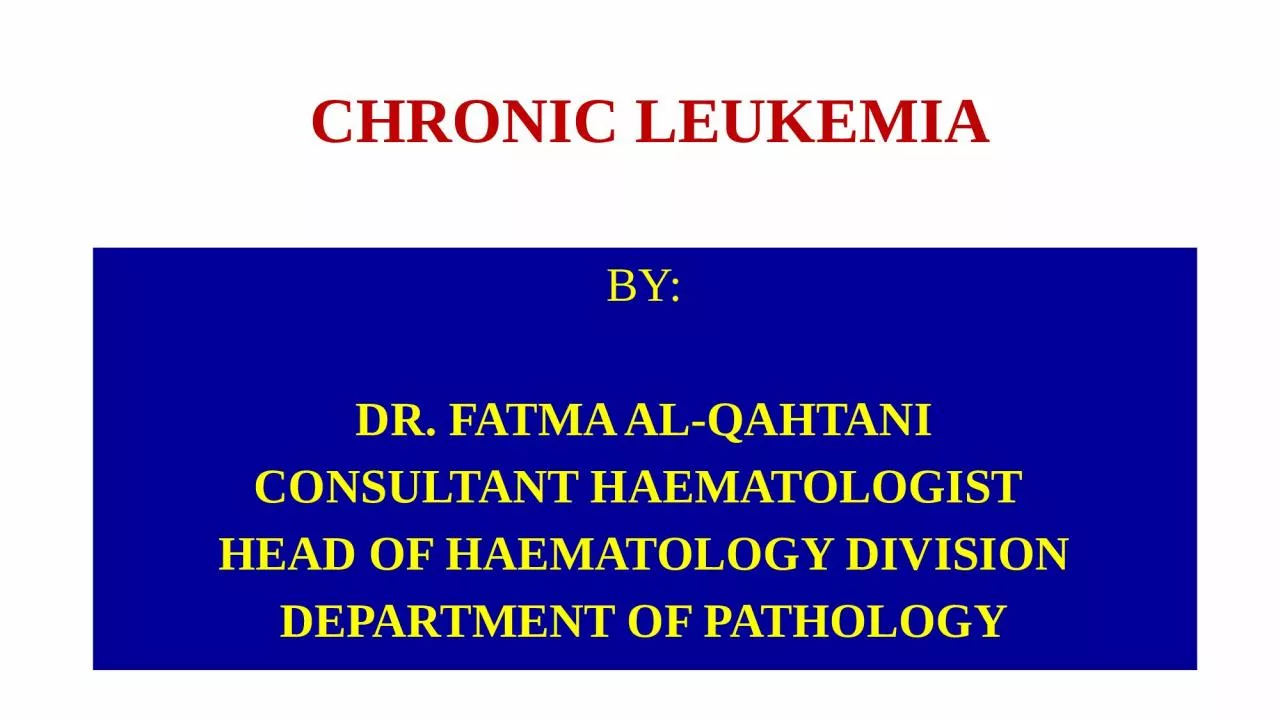

CONSULTANT HAEMATOLOGIST HEAD OF HAEMATOLOGY DIVISION DEPARTMENT OF PATHOLOGY Heterogeneous group of hematopoietic neoplasms Uncontrolled proliferation and decreased apoptotic activity with variable degrees of differentiation ID: 1043359
Download Presentation The PPT/PDF document "CHRONIC LEUKEMIA BY: DR. FATMA AL-QAHTAN..." is the property of its rightful owner. Permission is granted to download and print the materials on this web site for personal, non-commercial use only, and to display it on your personal computer provided you do not modify the materials and that you retain all copyright notices contained in the materials. By downloading content from our website, you accept the terms of this agreement.
1. CHRONIC LEUKEMIABY:DR. FATMA AL-QAHTANICONSULTANT HAEMATOLOGIST HEAD OF HAEMATOLOGY DIVISIONDEPARTMENT OF PATHOLOGY
2. Heterogeneous group of hematopoietic neoplasms Uncontrolled proliferation and decreased apoptotic activity with variable degrees of differentiation Composed of relatively mature cellsIndolent. (If untreated, the course is in months or years)Occurs mainly in adultsChronic Leukaemias
3. ErythroblastMegakaryoblastHSC
4. ChronicAcuteLPN(CLL)ALLLymphoidMPN/MDS (CML)AMLMyeloidAcute Biphenotypic MixedAcute UndifferentiatedNonMain Types of Leukemia
5. 55ALLAMLCMLCLL
6.
7. Malignant proliferation of myeloid cells (maturing cells) which are mainly granulocytes, in blood and bone marrow.Occur mainly in adultsSlow onset and long courseMyeloproliferative Neoplasms
8. Cytosis Organomegaly (mainly splenomgaly) High uric acid Hypercellular bone marrow Progression to acute leukaemia (mainly AML)MPN features
9. 9Stem cell MPN. Predominant proliferation of granulocytic cells. Consistently associated with the BCR-ABL1 fusion gene located in the Philadelphia (Ph) chromosome which results from t(9;22) .Chronic Myeloid Leukemia (CML)myeloblastpromyelocytemyelocytemetamyelocytebandneutrophilMATURATION
10. Activation of signal transduction pathways Tyrosine KinaseUncontrolled proliferationPathogenesis of CML
11. ABLBCRp210 kDPathogenesis of CML
12. Asymptomatic presentation(20-40%): Routine CBC : marked leukocytosis Common symptoms : Fatigue ,weight loss or night sweating Abdominal discomfort due to splenomegaly Splenomegaly (Massive )Clinical Presentation
13. LeukaemoidCMLAny ageAdultAgeHigh but <100,000HighWBC countMainly BandsMainly myelocytes and segmentedDifferentialToxicHypogranularMorphology-/++SplenomegalyHighLowNAP score-ve+veBCR/ABLAcuteChronicOnsetMain Differential Diagnosis1- Chronic myelomonocytic leukemia (monocytosis ,BCR-ABL –ve) .2-Leukemoid reaction: Leukocytosis due to physiological response to stress or infection
14. Neutrophil Alkaline Phosphatase (NAP)score : Cytochemical stain that estimate the amount of alkaline phosphatase enzyme in neutrophilis .Low : CMLHigh: Leukemoid
15. Leukocytosis (12-1000×10⁹/L)Mainly neutrophils & myelocytesBlasts ≤10% ,Basophils≤ 20%Stable course (years)Increasing counts 10-19% blasts (basophils ≥20%) Unstable course (months)≥20% blasts = Acute Leukemia80% AML & 20% ALL (coarse: Weeks)Chronic phaseAccelerated phaseBlastic phaseCML Phases
16. Targeted therapy (tyrosine kinase inhibitors like Imatinib)Excellent response (5y overall survival≥ 90%)If no response ; stem cell transplantationCML Treatment
17. Group of myeloid neoplasms characterized by: 1-Peripheral cytopenia ( Low HB ± Low WBC & Low PLT ) 2- Dysplasia (abnormal morphology) 3- Ineffective hematopoiesis (hypercellular marrow) 4-Progression to AML (preleukaemic disease) 5-Enhanced apoptosisMyelodysplastic Syndromes MDS
18. Blood: Pancytopenia with dysplasiaBM: Hypercellular with dysplasia Ineffective Hematopoiesis ProliferationApoptosisMyelodysplastic Syndromes MDSNormalDysplastic
19. 19MDS
20. Many subtypes according to: 1-Blast count 2-Degree of dysplasia 3-Genetics Variable genetic abnormalities mainly -5, -7Treatment : supportive +/- chemotherapyMyelodysplastic Syndromes MDS
21. Clonal Hematopoietic malignancy characterized by proliferation of both monocytes and neutrophils.MDS/MPN disease: * Features of MDS (dysplasia& enhanced apoptosis) *Features of MPN ( marked proliferation) Philadelphia chromosome must be negativeBlast must be less than 20%.Chronic Myelomonocytic Leukemia (CMML)
22. Aggressive course (survival rate around 2.5 y) Treatment : Chemotherapy ±SCTCMML
23. MPNMPN/MDSMDSCytosisCytopenia MPN vs. MDS vs. MPN/MDS
24. Thank you !!!